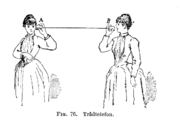
Tin can telephone
Encyclopedia

Tin can
A tin can, tin , steel can, or a can, is a sealed container for the distribution or storage of goods, composed of thin metal. Many cans require opening by cutting the "end" open; others have removable covers. Cans hold diverse contents: foods, beverages, oil, chemicals, etc."Tin" cans are made...
s, paper cup
Paper cup
A paper cup is a cup made out of paper and often lined with plastic or wax to prevent liquid from leaking out or soaking through the paper. It may be made of recycled paper and is widely used around the world.-History:...
s or similarly shaped items attached to either end of a taut string or wire.
How it works
SoundSound
Sound is a mechanical wave that is an oscillation of pressure transmitted through a solid, liquid, or gas, composed of frequencies within the range of hearing and of a level sufficiently strong to be heard, or the sensation stimulated in organs of hearing by such vibrations.-Propagation of...
waves
WAVES
The WAVES were a World War II-era division of the U.S. Navy that consisted entirely of women. The name of this group is an acronym for "Women Accepted for Volunteer Emergency Service" ; the word "emergency" implied that the acceptance of women was due to the unusual circumstances of the war and...
are created as the air vibrates in response to speech
Speech
Speech is the human faculty of speaking.It may also refer to:* Public speaking, the process of speaking to a group of people* Manner of articulation, how the body parts involved in making speech are manipulated...
or other sounds. The ear
Ear
The ear is the organ that detects sound. It not only receives sound, but also aids in balance and body position. The ear is part of the auditory system....
collects these sound waves and converts them into nerve impulses which the brain
Brain
The brain is the center of the nervous system in all vertebrate and most invertebrate animals—only a few primitive invertebrates such as sponges, jellyfish, sea squirts and starfishes do not have one. It is located in the head, usually close to primary sensory apparatus such as vision, hearing,...
interprets as sound.
When the string is pulled taut and someone speaks into one of the cans, its bottom acts as a diaphragm, converting the sound waves into longitudinal mechanical vibrations which vary the tension of the string. These variations in tension set up waves in the string which travel to the other can, causing its bottom to vibrate in a similar manner as the first can, thus recreating the sound.
History
In 1664–1665 Robert HookeRobert Hooke
Robert Hooke FRS was an English natural philosopher, architect and polymath.His adult life comprised three distinct periods: as a scientific inquirer lacking money; achieving great wealth and standing through his reputation for hard work and scrupulous honesty following the great fire of 1666, but...
experimented with sound transmission through a distended wire. In the centuries before tin cans and paper cups became commonplace, other cups were used and the device was sometimes called the "lovers' telephone". During the 20th century, it came into common use in preschools and elementary schools to teach children about sound vibration.

